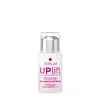What's inside
What's inside
 Key Ingredients
Key Ingredients

 Benefits
Benefits

 Concerns
Concerns

 Ingredients Side-by-side
Ingredients Side-by-side

Water
Skin ConditioningTriheptanoin
Skin ConditioningButylene Glycol
HumectantCoco-Caprylate/Caprate
EmollientC13-15 Alkane
SolventC9-12 Alkane
SolventDilinoleic Acid/Butanediol Copolymer
Polyglyceryl-6 Oleate
EmulsifyingPolysorbate 20
EmulsifyingDimethyl Isosorbide
Solvent1,2-Hexanediol
Skin ConditioningParfum
MaskingCastor Oil/Ipdi Copolymer
Xanthan Gum
EmulsifyingPPG-26-Buteth-26
Skin ConditioningOctadecyl Di-T-Butyl-4-Hydroxyhydrocinnamate
AntioxidantPEG-40 Hydrogenated Castor Oil
EmulsifyingAcetyl Tetrapeptide-11
Skin ConditioningAcetyl Tetrapeptide-9
Skin ConditioningSodium Hydroxide
BufferingDisodium EDTA
Phenoxyethanol
PreservativeWater, Triheptanoin, Butylene Glycol, Coco-Caprylate/Caprate, C13-15 Alkane, C9-12 Alkane, Dilinoleic Acid/Butanediol Copolymer, Polyglyceryl-6 Oleate, Polysorbate 20, Dimethyl Isosorbide, 1,2-Hexanediol, Parfum, Castor Oil/Ipdi Copolymer, Xanthan Gum, PPG-26-Buteth-26, Octadecyl Di-T-Butyl-4-Hydroxyhydrocinnamate, PEG-40 Hydrogenated Castor Oil, Acetyl Tetrapeptide-11, Acetyl Tetrapeptide-9, Sodium Hydroxide, Disodium EDTA, Phenoxyethanol
Water
Skin ConditioningGlycerin
HumectantPropanediol
SolventTriheptanoin
Skin ConditioningC13-15 Alkane
SolventCoco-Caprylate/Caprate
EmollientCarbomer
Emulsion StabilisingFaex Extract
Skin ConditioningApricot Kernel Oil Polyglyceryl-6 Esters
EmollientSoy Amino Acids
Skin ConditioningPunica Granatum Seed Extract
Skin ConditioningCetyl Diglyceryl Tris(Trimethylsiloxy)Silylethyl Dimethicone
Emulsion StabilisingHydrolyzed Yeast Extract
Skin ConditioningOlivine Extract
Skin ConditioningDilinoleic Acid/Butanediol Copolymer
Cellulose
AbsorbentPhenoxyethanol
PreservativeSorbitan Oleate
EmulsifyingSodium Metabisulfite
AntioxidantRetinal
Skin ConditioningGuanosine
Skin ConditioningUracil
Skin ConditioningPolyacrylate Crosspolymer-6
Emulsion StabilisingC9-12 Alkane
SolventCaprylyl Glycol
EmollientPolyglyceryl-10 Dipalmitate
EmollientDipropylene Glycol
HumectantSodium Hydroxide
BufferingGlyceryl Polyacrylate
Tocopherol
AntioxidantPvm/Ma Copolymer
Emulsion StabilisingAdenosine Phosphate
Skin ConditioningCastor Oil/Ipdi Copolymer
Potassium Sorbate
PreservativeHexadecene
SolventSodium Benzoate
MaskingT-Butyl Alcohol
PerfumingWater, Glycerin, Propanediol, Triheptanoin, C13-15 Alkane, Coco-Caprylate/Caprate, Carbomer, Faex Extract, Apricot Kernel Oil Polyglyceryl-6 Esters, Soy Amino Acids, Punica Granatum Seed Extract, Cetyl Diglyceryl Tris(Trimethylsiloxy)Silylethyl Dimethicone, Hydrolyzed Yeast Extract, Olivine Extract, Dilinoleic Acid/Butanediol Copolymer, Cellulose, Phenoxyethanol, Sorbitan Oleate, Sodium Metabisulfite, Retinal, Guanosine, Uracil, Polyacrylate Crosspolymer-6, C9-12 Alkane, Caprylyl Glycol, Polyglyceryl-10 Dipalmitate, Dipropylene Glycol, Sodium Hydroxide, Glyceryl Polyacrylate, Tocopherol, Pvm/Ma Copolymer, Adenosine Phosphate, Castor Oil/Ipdi Copolymer, Potassium Sorbate, Hexadecene, Sodium Benzoate, T-Butyl Alcohol
Ingredients Explained
These ingredients are found in both products.
Ingredients higher up in an ingredient list are typically present in a larger amount.
C13-15 Alkane is a group of alkanes with 13 to 15 carbon atoms in the alkyl chain.
It is a solvent and texture enhancer. Solvents are used to keep ingredients together in a product. They can help dissolve ingredients to stable bases or help evenly distribute ingredients throughout the product.
C9-12 Alkane is synethically created using alkanes, or paraffins. It is added to products as a solvent. This means its main purpose is to help dissolve ingredients and create even texture.
Castor Oil/Ipdi Copolymer is an oil and isn't fungal acne safe.
Coco-Caprylate/Caprate is created from fatty coconut alcohol, caprylic acid, and capric acid.
It is a lightweight emollient. Emollients create a thin barrier on the skin to trap moisture in. This helps keep your skin hydrated and soft.
Once applied, Coco-Caprylate/Caprate is absorbed quickly and leaves a silky feel.
Coco-Caprylate/Caprate may not be fungal acne safe.
Learn more about Coco-Caprylate/CaprateWe don't have a description for Dilinoleic Acid/Butanediol Copolymer yet.
Phenoxyethanol is a preservative that has germicide, antimicrobial, and aromatic properties. Studies show that phenoxyethanol can prevent microbial growth. By itself, it has a scent that is similar to that of a rose.
It's often used in formulations along with Caprylyl Glycol to preserve the shelf life of products.
Sodium Hydroxide is also known as lye or caustic soda. It is used to adjust the pH of products; many ingredients require a specific pH to be effective.
In small amounts, sodium hydroxide is considered safe to use. However, large amounts may cause chemical burns due to its high alkaline.
Your skin has a natural pH and acid mantle. This acid mantle helps prevent harmful bacteria from breaking through. The acid mantle also helps keep your skin hydrated.
"Alkaline" refers to a high pH level. A low pH level would be considered acidic.
Learn more about Sodium HydroxideWe don't have a description for Triheptanoin yet.
Water. It's the most common cosmetic ingredient of all. You'll usually see it at the top of ingredient lists, meaning that it makes up the largest part of the product.
So why is it so popular? Water most often acts as a solvent - this means that it helps dissolve other ingredients into the formulation.
You'll also recognize water as that liquid we all need to stay alive. If you see this, drink a glass of water. Stay hydrated!
Learn more about Water